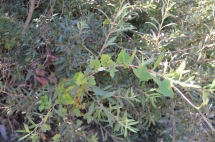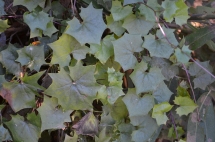Overview
Cape ivy growth is rapid and very dense, creating an extremely high potential for negative impacts to native plants and wildlife species.
Southern California riparian ecosystems are already heavily altered by anthropogenic disturbances which have facilitated the invasion of other invasive species, but the incorporation of invasive vines like Cape ivy brings an entirely new guild into these systems that are critical habitats for many sensitive wildlife species.
Expansion into relatively undisturbed chaparral ecosystems is a disturbing new phenomenon, as these systems have been considerably resistant to non-native species invasions.
Introduction
Originating from South Africa, this plant tends to be found in low elevation with preference towards disturbed areas such as stream banks. In California, the vines reproduce only vegetatively, re-sprouting from broken fragments of either rhizomes or stolons. The vines can climb to heights of up to five meters and grow up to one foot per month, making this invasive species difficult to control. The leaves contain toxins such as pyrrolizidine alkaloids, which are inedible to birds and wildlife, thus further promoting unabated covering and smothering of vegetation.
Ecological Effects
Cape Ivy has a shallow root system, no more than 30 inches, leading to soil erosion and flooding along hillsides and streams. This erosion and related flooding can break the vines and cause it to reestablish downstream.
Invasion by Cape Ivy leads to a decrease in biodiversity and reduces the amount of native plats in an area, possibly leading to further invasion by other species.
The dried plant mass, especially after a frost, serves as fuel for fires.
Potential Control
A biological control program is being developed for management of Cape ivy infestations, with two agents proposed for experimental field testing to determine its capacity for development and target impact under field conditions (Balciunas et al. 2004). However, no field trials are planned for southern ecosystems, despite increasing evidence that Cape ivy impacts may be very significant in this region. Thus, there is a need to expand the biocontrol program to determine suitability of candidate agents in this region. But before such research testing can take place it is important to justify the potential introduction of specialist herbivores for Cape ivy control by establishing information on the ecological associations of Cape ivy in southern California, its growth dynamics, and its interactions with native plant species. Such information is critical for establishing a baseline for comparison when and if biocontrol agents can eventually be released in the region.
Related Presentations:
Ecology and control of Cape ivy; So. Calif. Wetlands program; May 2007; T. Dudley
Biocontrol of Cape ivy; Ventura Co. Watershed Council; April 2007; T. Dudley
Ecology and control of Cape ivy; Rincon Creek Council; March 2007; T. Dudley
Ecological role of Cape ivy in southern California riparian ecosystems; Calif. Invasive Plant Council; October 2007; N. Molinari, K. Seward, F. Burton & T. Dudley
Ecophysiology of invasive Cape ivy; Senior Thesis & presentation; F. Burton


 Cape Ivy wrapping around native vegetation
Cape Ivy wrapping around native vegetation Cape Ivy
Cape Ivy